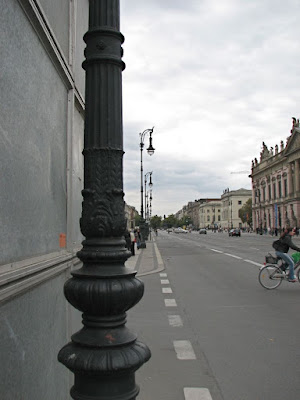Quirks of Berlin (and of my mind)
For a tourist, there's always stuff to see that doesn't fit typical tourist photo categories. This is the stuff that reminds a tourist that she truly is not at home, but somewhere else. Here are some photos of how Berlin reminded me of that fact.

I enjoyed the lampposts on parade on Unter den Linden, wondering who was the kind soul who set up such a nice motif for a photographer.

Anothr nice motif on Unter den Linden.

A detail at the foot of one of the columns of Brandenburg Gate.

Berlin is a city of both old and modern architecture and the embassy complex shared by five Nordic countries expresses a bold and yet uniquely Scandinavian architecture. Each modern building uses materials native to the country it represents. A lot of wood and stone.
Berlin's water table is only about 2-3 meters down, so whenever there is digging, the water has to be led away. This and the temporary rerouting of water supplies is done with colorful pipes above-ground. I saw many colors. These pipes near Potsdamer Platz looked like an abstract sculpture.


Berlin's symbol is the bear, and many versions of it dot the city. I encountered this European Union bear in Niederkirchnerstrasse, visiting the Berlin wall.


Old East Germany had its own version of the walk/don't walk signs. Their standing red man and walking green man have rounder and cuter shapes, and are sometimes not even men, but women with braids. The former DDR is actually fighting to keep this quirk, rather than follow the stylized standard used elsewhere.


To this non-German speaker (more or less), some street names and signs gave rather odd associations:

"Defeat" in Norwegian is "nederlag". I have no idea what defeat Niederlag street is named for.

"Invalid" means void in English; in Norwegian it means is a disabled person. Turns out that that's what it means in German, too. There used to be a veteran's hospital on this street. Before I found out, I amused myself by wondering if the street was invalidated or handicapped.

For a moment, I wondered if there were six other parks, named for the other deadly sins. "Lust" means "pleasure" in German, and this is Lustgarten, Pleasure Park, next to the Berlin cathedral.
Thus ends my visit to Berlin. All that was left was the trip home, a mad dash to the Oslo ferry leaving from Kiel, and then a train from Oslo to Bergen. But there is one more thing I want to do next time I'm Berlin: Take this boat ride. I was sorry I didn't think to do it this time around.



Comments
One thing that struck me as a kid when I used to visit mainland Europe, and it struck me again seeing your pictures, is how clean and tidy everything is compared to the UK and the US.
And I do like the walk/don't walk signs. God forbid the EU gets rid of those.
I have to persuade my Irishman to take me to Berlin soon; he lived 10 years in Germany, so the language should not be a problem.;))
Pearl
Tom, whenever I leave Norway (even for the UK or US), everything is instantly neater and cleaner, and there are helpful signs everywhere. Nothing outdoes Germany, though.
Protege, Berliners willingly speak English (I found) so even if your Irishman's German is rusty, you'll do fine.
Hi, Pearl, and welcome. I'm happy you liked my post!